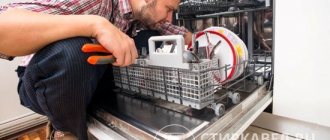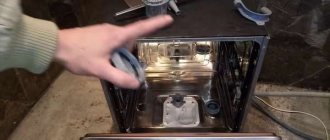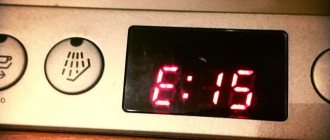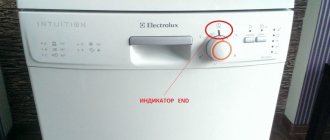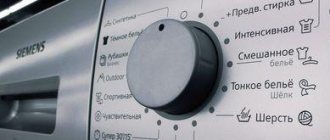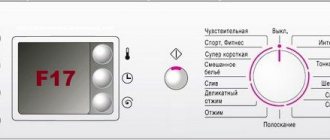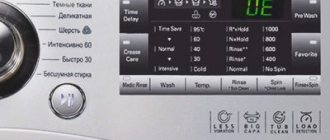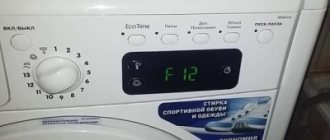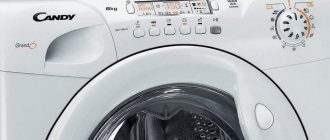Kaiser dishwasher error codes
The photo shows examples of PMM control panels Kaiser S 4562 XL and Kaiser S 6062 XL.
Modern Kaiser dishwashers are equipped with full-fledged control and self-diagnosis systems that can check in real time all the important details of the device’s operation. The fault code is displayed on the dashboard display in alphanumeric form.
This article describes only those error codes that are displayed to the user during normal operation of the dishwasher. To more accurately determine the cause of the problem, there is a test mode, which is launched by a special key combination: it is intended for specialists, and we will not describe it here.
For different Kaiser PMM models, the sets of error codes are slightly different, but not much. First, in the article we will describe their maximum list, and for other sets we will refer to the first table of error codes.
Error codes for PMM Kaiser S 45I70 XL
The described set of error codes is issued on dishwashers Kaiser S45I70XL, Kaiser S45I80XL, Kaiser S60I70XL, Kaiser S60I80XL. All of the listed models are equipped with a display, so error codes are displayed in alphanumeric format.
There are many possible reasons, some of which you can check and eliminate yourself:
A similar error can only result from a breakdown of one of the parts involved in the water heating procedure:
If the water pressure at the entrance to the PMM is too strong, the fill valve is difficult to close and, as a result, too much water may pour into the chamber
The thermistor control circuit is broken. Obviously incorrect information is received from the temperature sensor; as a result, the water in the bunker either does not heat up at all, or does not heat up to the set temperature, or overheats:
Error E5
In a Kaiser dishwasher, this code indicates a faulty temperature sensor. A malfunction of its operation can occur in the event of a short circuit in the heating elements, in the sensor itself, or in the switching electrical circuits.
To determine the location of the short circuit, it is necessary to check the insulation resistance of all listed elements of the electrical circuit. A megohmmeter is used for this. If a short circuit occurs in any part of the electrical circuit, the device will show a zero insulation resistance value. Depending on the complexity of the insulation failure, it can be restored or individual elements of the electrical circuit replaced.
Error codes PMM Kaiser S 4570 XL
The set of error codes for dishwashers Kaiser S4570XL, Kaiser S4570XLGR, Kaiser S45E70XL, Kaiser S4571XL, Kaiser S45U71XL, Kaiser S4581XL, Kaiser S6071XL, Kaiser S60U71XL, Kaiser S6081XL differs quite a bit from what was previously described. All models are equipped with a display where the error is displayed.
| Code | Description | Remedy |
| E1 | Problems with water intake: the chamber takes too long to fill | See the description of error “E1” above |
| E3 | Water heats up too slowly | See the description of error “E3” above |
| E4 | Too much water pressure or overflow | See the description of error “E4” above |
| E6 | Open circuit in the temperature sensor circuit | See the description of error “E6” above |
| E7 | Short circuit in the temperature sensor circuit | See the description of error “E7” above |
| E9 | Sensor or button error | See the description of error “E9” above |
Error codes for Kaiser dishwashers
Dishwashers from the German company Kaiser have conquered markets in almost all countries of Eastern Europe and Russia. But no matter how much the developers care about extending the maintenance-free operation of their products, the time still comes and the equipment begins to gradually fail. This especially often happens when operating rules are violated or low-quality water is used.
The developers of Kaiser dishwashers took into account the requirements of customers and developed a self-control system. Its essence boils down to the fact that in the event of any defects, the Kaiser dishwasher system analyzes the breakdown and provides the user with information in the form of error codes.
Error E2
An error warns that the filling time has been exceeded. This failure can occur for the following reasons:
- low pressure in the water supply network,
- the solenoid valve is damaged,
- The intake hose is dirty or the filter device is clogged.
To repair damage to your Kaiser dishwasher, do the following:
- check the pressure in the water supply system. Maybe it has dropped to a critical value or the water supply has stopped,
- check the functionality of the shut-off valve. Maybe it's just closed
- check the electronic circuit of the filling valve,
- disconnect the filling hose from the PMM and clean it. Inspect the cleaning filter, and if it is clogged, clean or replace it.
Difficulty deciphering the error code
There are a number of breakdowns that distort one or another error code. We are talking about malfunctions in electronic circuits. For example, any damage to the electronic control circuit of a Kaiser machine can lead to a malfunction of the self-diagnosis device, and then various error codes may spontaneously appear on the display that do not reflect the true breakdown.
Some codes in Kaiser dishwashers may combine not a specific single defect, but several breakdowns, with different mechanisms and components. Therefore, it is recommended to be very careful and not trust 100% in decoding errors. If possible, it is recommended to find other ways to determine the true error.
However, the developers of Kaiser dishwashers believe that it is better for the user to know the essence of the defect and be able to answer the question of what to do and how to correct the situation.
Solving electronics problems
After a power surge, the dishwasher does not turn on? Indicators do not light up, buttons do not respond to pressing? The reason may be a burnt board, wiring, or a broken network cable.
- Condition of the power cord and plug. If the insulation is damaged or scorched, replacement is required.
- Socket status. External damage immediately indicates a breakdown. To check its functionality, connect another device to it.
To diagnose electronics, it is better to contact a specialist. To avoid problems and serious repairs, follow the connection rules:
- Use only a separate grounded outlet.
- Do not include the PMM in the carrier.
- Use a voltage stabilizer. In case of changes, it can save not only the dishwasher, but also the washing machine and refrigerator.
In the first year of operation of the PMM, problems associated with the operation of the equipment occur. Therefore, read the instructions carefully, do not forget to care for the device and carry out timely cleaning.
Source of the article: https://270076.ru/posudomoechnye-mashiny/neispravnosti-posudomoecnyh-masin-kajzer/
Error E4
The code is displayed when the water level sensor is activated. This indicates an overflow of water. The following problems may be the cause:
To eliminate the listed damage in a Kaiser dishwasher, it is recommended to do the following:
Error E3
The error symbolizes that the water drainage time has been exceeded. In a Kaiser dishwasher, this error indicates the following failures:
- the pump impeller is blocked;
- the drain filter is clogged;
- The drain hose or siphon is clogged. The sewer system may be clogged.
Troubleshooting methods:
- it is necessary to remove the pump cover and clean the impeller from blockages;
- clean the drain filter. To do this, you need to open the chamber door and remove it from the tray. The filter is cleaned under the pressure of running water;
- remove the drain hose and, if necessary, rinse under running water;
- check the siphon and sewer system. If necessary, they must be cleaned of contamination.
Kaiser dishwasher malfunctions: DIY repairs
It is recommended to entrust the installation of the device in a niche, connection to communications, as well as securing the decorative door on built-in models to specialists.
The device is installed on a level surface. First, the supply hose with the Aqua-Stop system is connected, it is located in a special niche on the back wall, it is attached to the water supply tap. The hose can be connected to both a cold and hot water source, but it should not be higher than 60°C. Using hot water reduces the wash cycle and reduces energy consumption. The tap will need to be fully opened after connecting the machine to the sewer.
The drain hose is connected through a tee or directly to the sewer pipe; you can put the hose in the sink; use the special mount that comes with the kit. It is important to check that the end of the tube is at a height of between 40 and 100 cm, and is not submerged in water, squeezed or kinked.
If you need to disconnect the machine from the communications, first disconnect the supply hose and then the drain hose. Please note that if the water is drained into the sink, some of the liquid will remain in the system, so you need to prepare a bucket or other vessel whose height is lower than the sink level.
Error E1
The error indicates a faulty door lock. The control circuit of the blocking device does not receive a signal to activate it. The absence of a signal may be due to the following reasons:
- The loading hopper door is not completely closed,
- the locking lock or sensor is damaged,
- There is a malfunction in the electrical control circuit of the locking device.
To resolve the error, it is recommended to do the following:
- check that the door is closed tightly,
- check the functionality of the locking lock. If necessary, it must be replaced,
- Check the electrical circuit for controlling the locking device. Pay attention to the presence of electrical connection between the board and the blocking actuator. If necessary, the cable is replaced.
Usage
Check the presence of salt and rinse aid, then add powder or 3-in-1 tablets into the reservoir. Load dishes into the baskets and check that the operation of the rocker arms is not blocked. Then select a program depending on the degree of soiling of the dishes. If you have a lot of different dishes, then divide them into two cycles.
For example, place pots, frying pans, baking sheets in the lower basket, bowls and dishes in the upper basket and select “Intensive mode”.
For the next cycle, place soup and large flat plates in the bottom basket, and glasses and tea cups in the top basket. They can be washed using the “Short” or “Normal” programs.
Make sure there is detergent in the reservoir and close the door firmly.
Dishwashers operate very quietly, but if you listen closely, you can hear water being poured into the reservoir. When the program ends, a beep will sound.
Open the door carefully as hot steam will escape. If you are sure that there will be no children or pets nearby, you can leave the door ajar until the dishes have cooled completely. Although safety rules recommend emptying the car and keeping the door closed.
Errors 0E, 0F, 0C, E3 on a Samsung washing machine
What's happened
The washing machine display showed an error message “0E”,
In models without a display, the indicators for all washing modes + two lower temperature indicators light up.
What does an error mean?
There is too much water in the car.
Why did the error appear?
● The drain hose is not connected correctly to the sewer;
● The water fill valve is blocked in the open position.
What to do next
Unplug the machine from the outlet.2 Disconnect the drain hose from the sewer (siphon, pipe). If you extended the drain hose, remove the extended part.3 Lower the end of the drain hose into the bathtub or sink.4 Turn on the machine and run the same wash cycle.
Do not wait for an error to appear if the machine has filled a full drum of water. Stop the wash by pressing the Start/Pause button and submit a repair request.
If the error does not appear, it means the drain hose was connected incorrectly. To ensure that the machine operates without errors, properly connect the drain hose to the drain.
The sound of water pouring is heard
If you hear the sound of water filling, but the machine still gives an error, then:
- or there is too much laundry in the machine for the selected washing mode,
Information on the maximum load of laundry for each washing mode is indicated in the user manual, section “Operation” or “Instructions for washing laundry”. or things that are loaded into the drum absorb a lot of water: pillows, blankets, etc.
For washing, a certain amount of water is poured into the machine. If things absorb more water than planned, the level in the machine will decrease. The sensor will detect this and the machine will show an error.
If there are not many things loaded and there are no things that absorb a lot of water, then check the water pressure through the inlet hose. If the pressure is weak, an error will appear. In this case, contact a plumber.
I can't hear the sound of water pouring
If, after starting the wash, you do not hear the sound of water filling, and the machine shows an error, then:
- Make sure the water supply tap to the washing machine is open.
- Make sure there is cold water in the house. To do this, open the cold water tap. If there is no water or the pressure is weak, contact a plumber. The washing machine will not be able to start washing without water.
- If the tap is open and there is water in the house, check the water pressure through the inlet hose.
- If the pressure is strong:
A. Remove and clean the filler strainer.
B. Make sure the drain hose is connected correctly: it should come out of the machine and go straight down. If the hose is not positioned correctly, water will drain from the machine and it will show an error.
How to properly connect the drain hose
C. Unplug the machine for 15 minutes to reset the control unit.
D. Plug in the machine and run the same wash cycle.
E. If the error does not appear, continue to use the machine, everything is fine with it. If the error appears again, contact support.
If the pressure is weak:
Contact a plumber. The washing machine will not be able to start washing with low water pressure.
If there is no pressure:
A. Unscrew the other end of the hose from the water pipe and try to pour water into it.
B. If water is coming through the hose, have a plumber check the water supply valve and water pipe. If water does not pass through the hose, it is clogged. Buy a new hose or wash it with a strong stream of water.
Control
Modern Kaiser dishwashers are equipped with touch control panels with an LCD display indicating the time until the end of the program, delayed start, error codes and program settings. Depending on the model, activation buttons “3 in 1” and “Half load” are provided. The program selection icons are intuitive.
Display of Kaiser S 45I84 XL, S 60I84 XL models
First of all, you need to make sure that this is not a system failure. For this:
If the reboot does not help reset the code, the icons continue to light, we roll up our sleeves and look for the causes of the malfunction.
Errors H1, H2, HE, HE1, HE2, HC, HC1, HC2, E5, E6 Samsung washing machine
What's happened
The washing machine display showed an error message H1, H2, HE, HE1, HE2,
In models without a display, the indicators of all washing modes + the bottom and second temperature indicator from above light up
or indicators of all washing modes + two central temperature indicators.
Do not confuse with the 2H, 3H or 4H indication - this is the time until the end of the wash.
When the error appears
The error appears if you select a washing temperature of 40°C or higher. If you select a lower temperature, the error will not appear.
How not to make a mistake when identifying a defect?
Deciphering this or that error code helps to find almost any malfunction of the Kaiser dishwasher, but you should not rely too much on such a decoding, because in some cases it can only confuse the technician. We are talking about electronic defects, namely the control board of the Kaiser dishwasher and the firmware. One or another firmware failure in half of the cases negatively affects the operation of the self-diagnosis system. It begins to spontaneously issue different error codes without any reason, forcing the user to disassemble the machine and look for breakdowns where there are none.
Some error codes are so extensive that they do not identify a specific defect, but only a possible range of defects that you should pay attention to, first of all, when searching for a problem. Therefore, be extremely careful and do not trust the decryptions 100%, but you must use them, otherwise the search for the problem will be significantly delayed.
Some models of Kaiser dishwashers have a special self-diagnosis system with an expanded package of error codes.
Meanings of error codes and recommendations for troubleshooting Gorenje breakdowns
Below we list the designations of fault codes that the user may encounter when operating the Gorenye dishwasher. In the tables below, the causes are presented in rating form, starting from the problem with the greatest probability and ending with the least.
E1 – activation of the leakage sensor and detection of water in the tray
Appears if the float sensor of the “Leakage Protection” system is closed for more than 3 minutes, if water leaks into the pan. In this case, the pump will operate until the element contact opens.
| Cause | How to fix |
Water entered the pan due to a leak in the tank from the Aquastop system hose.
Internal components of the housing may also leak - pump, recirculation pump, etc.; connecting pipes.
Drain the tray so that the contact of the tank full sensor opens. This is followed by restarting the dishwasher to check and find the location of the leak.
The leakage is eliminated and the machine can be used.
A malfunction of the electronic board is obvious if none of the four failures listed above are confirmed.
How to reboot the machine to determine the module failure:
· select the washing mode;
· close the loading hatch;
· if after 3 minutes or less the PMM displays error code E1, it means that the problem is still in the unit and it needs to be replaced.
E2 - the level sensor of the Gorenye dishwasher has tripped
The system signals error E2 if the water level has crossed a certain mark and an overflow is detected. The Gorenye dishwasher stops the user-specified program, starts the pump to drain the water, and displays an error on the display (or the indicators flash).
Important! To immediately rule out a failure of the control board, you need to carry out the following check:
After emptying the dishwasher tank, check the operation of the pressure switch using an ohmmeter.
If the relay needs to be replaced, install a new part.
Select a mode and turn it on. Make sure the pump delivers water evenly without creating bubbles.
If the water supply is intermittent, you need to inspect the pump hose that passes through the pan - it may be clogged.
If the problem is not solved, the part needs to be replaced.
The repair involves closing the water valve to regulate the pressure of the water flow. After this, reboot the device several times to make sure the problem is resolved.
If the E2 code comes back on, the intake valve will need to be replaced.
E3 – no heating
Warning lights or an error code appear on the user panel when the water heats up too slowly - less than one and a half degrees in 20 minutes.
| Broken or clogged wash pump. |
| The water intake rate at the inlet valve has been exceeded - the rarest cause of this error. |
| Causes | How to fix |
| Triggering of the heater thermal fuse (if one is provided in the design). |
Using a tester, measure the resistance of the fuse. If “0” lights up on the device screen, it means “closed”, there is no operation. If the measurements report: “open,” then the fuse has tripped to protect the heating element from overheating and burnout.
In the latter case, the thermal fuse trips due to one of two possible reasons:
1. The thermistor position is broken.
2. The washing pump is deformed.
Error code table: Kaiser dishwashers
Error E1
If you believe the statistical data provided by service centers in Europe and Russia, the main breakdowns of Kaiser dishwashers are associated with improper operation and connection, or with a poor electrical network. Of the 1,000 recorded situations where repair of a Kaiser dishwasher was required, in 897 cases the cause of the breakdown was user errors made during operation, in 89 cases the culprit of the breakdown was a poor-quality electrical network, and only in 14 cases it was a manufacturing defect or poor assembly.
For your information! Above are the statistics of calls to service centers regarding breakdowns of Kaiser dishwashers in the first year of operation. In total, in 2014-2015, 1,368 cases of user requests from European countries and the Russian Federation were recorded when repairs were actually required.
What are the most common causes of failure of Kaiser dishwashers?
Typical malfunctions and error codes of Kaiser dishwashers
Each manufacturer strives to differentiate its dishwashers in the market. Thus, Kaiser units are made of corrosion-resistant materials; they use a minimum amount of detergent when washing. Despite the advantages, there are also disadvantages - these are breakdowns. But problems are not always the fault of the manufacturer.
Here is the data recorded by service centers:
- During the year, 1,000 calls to the service were received.
- Of these, 800 are due to operational problems.
- Approximately 90 cases are problems with network instability.
- Only 14 cases were problems with assembly or manufacturing defects.
This once again confirms how sensitive foreign technology is to the quality of electricity in the network. Therefore, it is cheaper to install a stabilizer than to spend money on repairs.
Main causes of problems:
- Blockages in the filler and drain lines.
- Electronics malfunction.
The machine can independently notify the user of a breakdown. The diagnostic system writes error or another code on the display, which, when decrypted, indicates the location of the malfunction. The most common mistakes:
- E01 - loading door is not closed. Damage to the electronic lock.
- E02 - problems with water intake into the tank.
- E03 - lack of drainage of waste liquid.
- E04 - overflow in the system.
- E07 - leak. The Aquastop protection worked.
- E08 - network failure.
- E21/E22 - problems with the operation of the engine, tachometer.
What to do if a problem occurs? First try to find out its reasons, maybe you can handle it on your own. When the code first appears on the display, reset it. Reboot the equipment:
- Disconnect the machine from power.
- Wait 10–15 minutes.
- Turn on the dishwasher.
If the error does not disappear, then there is a problem. Our instructions will help you cope with the breakdown.
Clogged drain system
There is a category of dishwasher users who believe that if they have paid money for good equipment, then they can use it to the maximum without bothering with caring for it. It usually ends badly - the dishwasher stops working. In some cases, users, trying to figure out the problem on their own, clean the filters and rinse the drain hoses, but the problem still remains.
Experts say that if you do not clean your dishwasher, it may require repairs, because blockages can cause damage to the pump or heating element, and this is already serious. If a blockage occurs, you cannot continue to operate the Kaiser dishwasher; you must immediately stop the washing process, and then carry out a complete cleaning, both manually and using special products. For more information on how to clean dishwashers, see the article about replacing and cleaning the dishwasher filter.
Filling system clogged
Decoding the code
This is a complete list of Kaiser dishwasher error codes. However, experts do not advise rushing to fix any breakdowns on your own. If an error code appears on the display during operation, there is no need to panic. First you need to turn off the machine and let it rest for 30-40 minutes. Then the machine turns on again. If the error code does not disappear, then you need to decide to fix the defect yourself or send it to service. It is better, of course, to invite a specialist or contact a service center. Incompetent intervention in a complex mechanism can cause much greater harm.
Fixing error e4 in the dishwasher
How Samsung fault codes are deciphered
What malfunctions can be found in dishwashers? In the table below we have provided a breakdown of each code, and also suggested ways to troubleshoot the problem.
2. The water supply tap is closed.
3. The inlet hose is clogged or pinched.
4. The door is not closed properly.
2. Turn the shut-off valve; it may have been closed.
3. Inspect the water intake hose. It should be level. Maybe he was bent over or pinched by some object.
4. Close the door more tightly. It is equipped with a locking lock. Until the lock locks the door, washing will not begin.
3. The drain system is clogged.
1. Inspect the drain hose that connects the dishwasher to the drain. If it is pinched or twisted, the water will not drain.
2. The filter located at the bottom becomes clogged with food debris. For normal drainage, clean the filter. But first, press the “Drain” button.
3. To check the drain hose for clogs, disconnect the end from the drain and place it in a bowl. If the drain does not occur, then you need to remove the hose and clean it of food debris and dirt.
2. The thermostat is broken.
1. Check that communications are connected correctly. If the car is new, you may have mixed up the hoses.
2. Check the set mode. If a delicate wash is set, the heating temperature will not exceed 40 degrees.
3. Inspect the Samsung dishwasher filter for clogs. When the water circulation is reduced, the heating element does not turn on.
4. Inspect the heating element. If it is overgrown with scale, it means the element needs cleaning. If the heater burns out, it will need a complete replacement.
5. Install a new thermostat if it is faulty.
1. Check the level sensor and replace it if faulty.
2. The dishwasher filter is clogged.
2. Clean the filter from blockages.
2. During operation, the button was pressed through.
Before you start troubleshooting, unplug your Samsung dishwasher and turn off the water supply.
If the error appears on the screen for the first time, it is important to know how to restart the PMM. Rebooting is carried out by disconnecting the machine from the network for 15-20 minutes. If after turning on the error appears on the screen again, you need to look for the problem.
If you do not understand the dishwasher, entrust the repair to a specialist. It’s easy to damage parts, but restoring them can take a long time.
Decoding the code
Error code e4 in a dishwasher means “too much water.” This may mean that one of the pipes is leaking, or the plug on the inlet hose has become unusable, which is why liquid has accumulated in the tank with a volume exceeding the permissible norm. You can repair this fault with the help of a specialist or with your own hands. However, the services of a specialist are expensive - about 8 thousand rubles, so it will be easier to do the repairs yourself.
When error e4 occurs, the aquastop emergency system is activated. This means that the pan is full, and now it’s impossible to do without at least the initial draining of all the stagnant and non-flowing water. This is an initial measure and in order to understand how to fix error e4 in a dishwasher, you will first need to disassemble it and repair the broken parts. Next, we will look at the possible causes of leaks inside the machine and ways to eliminate them.
Possible causes of leaks inside the dishwasher
It is difficult to understand the reasons for the error without opening the housing and checking the sockets, pump and other elements of the drainage system. However, here it is necessary to mention the most common of them:
- Hose coming off the pump
- Leaking drainage system pipes
- Pump malfunctions
A slipped pipe as a possible cause of dishwasher flooding
How to disassemble a dishwasher
So, you can fix equipment problems either by repairing parts or replacing them with new ones. To do this, you should disassemble the dishwasher according to the following scheme:
- Disconnect the plug from the socket;
- Shut off the water supply to the water pipe to which the inlet hose is screwed, then unscrew the securing clamps;
- Prepare a floor bucket and rags in case there is water left inside the machine;
- Remove all containers for dishes from the machine hopper;
- Carefully place the machine on its side;
- Using a screwdriver and wrenches, unscrew the fixing screws holding the back wall, as well as the tray. Don't forget to also unscrew the top cover. Now you can not only inspect the pump, but also inspect all the other “insides” of the dishwasher;
- Now remove the aquastop from the machine. This device blocks the uncontrolled release of water in the event of a system failure. In many ways, it is thanks to the aquastop that it is possible to avoid serious leaks during error e4;
Diagram of a pump with aquastop
Important! The old generation Aquastop often ignores small leaks that form as a result of small tears in pipes and hoses, which is why the indicator that lights up when there is a leak will not light up. In this case, you will have to identify the error the old fashioned way - check whether there are any puddles left after the cycle, since leaks can be very insignificant at first.
Now that the sensor has been removed, you can proceed directly to the repair and installation work. The main advantage of the location of the pump is that you do not have to completely disassemble the machine and do not have to photograph the disassembly process itself, since the location of the walls, panels and ceilings is easy to remember.
We are looking for the cause of the problems
After disassembling the machine, collect all leaked water with rags in a bucket and begin inspection. If you find that the hose connecting the pipes to the pump has fallen off, loosen the clamp securing it on the back side and inspect the hose from the inside.
Pumping system with aquastop
It often happens that the reason the hose comes off is a critical level of pressure. This may be caused by a blockage in the hose itself or at the place where it connects to the pipes. This can be caused by various types of blockages. For example, scale - residues of mineral salts and other chemical elements settling inside the machine. Over time, the salts harden and can form a solid barrier. This can lead to failure of the entire drainage system, so it is best to take preventive measures - add special salts to soften hard water when starting the dishwasher. Otherwise, this may lead to a major breakdown that cannot be fixed on your own, and you may have to purchase a new dishwasher.
The second possible cause of problems recognized by the system under code e4 is a leak in one of the pipes or hoses in the drainage system. It can leak at the junction of hoses and pipes, or from holes in the body. In the first case, you just need to re-tighten the clamps or change the rubber gaskets, which are commercially available in plumbing stores. If you find a leak on the body, then you will have to replace the spare parts. Do not tighten it with tape or tape - this can lead to more serious problems in the future.
